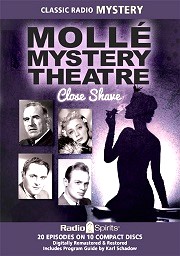
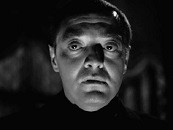 Mollé Mystery Theatre (1943-51) aired “Lady in the Morgue” on May 15, 1945 as the 84th of its estimated 237 episodes from its 1943-48 original run before it switched to CBS for its final 3 years, of which only 73 of the 237 are known to still remain in circulation. It would exist under several name changes for another six years or so, and as noted would switch from its original network, NBC, to CBS (1948-51), and then ABC. Its glory years as a first class mystery show are acknowledged as those comprising its original incarnation at NBC (i.e. 1943-48). A number of its episodes would be aired on the AFRS (Armed Forces Radio Service) under its Mystery Playhouse title, of which this episode is one.
Mollé Mystery Theatre (1943-51) aired “Lady in the Morgue” on May 15, 1945 as the 84th of its estimated 237 episodes from its 1943-48 original run before it switched to CBS for its final 3 years, of which only 73 of the 237 are known to still remain in circulation. It would exist under several name changes for another six years or so, and as noted would switch from its original network, NBC, to CBS (1948-51), and then ABC. Its glory years as a first class mystery show are acknowledged as those comprising its original incarnation at NBC (i.e. 1943-48). A number of its episodes would be aired on the AFRS (Armed Forces Radio Service) under its Mystery Playhouse title, of which this episode is one.
None other than legendary Hungarian-born actor Peter Lorre (1904-1964, photo top right) sets the stage for “Lady in the Morgue” as he hosts this episode with remarks to open and close the story. His creepy, made-for-horror delivery provides an atmospheric taste of what is to follow in this noir tale, and a dark and chilly set piece it is that opens with two detectives hired by a man from out of town who tasks them to watch over a certain young lady whose corpse was delivered to the morgue after she was found hanged, for the man paying the detectives to spend the night in the morgue corpse-sitting believes the dead woman may be his wayward sister and wants to make sure nothing happens to her before he can arrive to verify her identity one way or the other and possibly claim her remains. When the man arrives and is escorted down into the depths of the morgue by our brace of detectives, the woman’s body is missing and the morgue attendant is found murdered. And with this shocking event we are off to the races, dear listener, for with the murdered morgue attendant there is now one irrefutable murder to go along with either the suicide or murder of the young woman, not to mention a boatload of new questions, just a few of which are who murdered the attendant? Who stole the unidentified corpse, and again, why? And who was the deceased woman in the first place that made her corpse worth stealing? And all this has happened in the first few minutes! While our detectives along with the police begin collecting and following clues, it doesn’t take long before complications arise, along with another murder. The case has gotten complicated, with plot twists and surprises around every corner, making it impossible for the listener to keep pace with this cleverly written murder mystery. So sit back now and discover how one lonely “Lady in the Morgue” can cause so much damage to the living.
[The linked Mollé Mystery Theatre CD pictured above includes “Lady in the Morgue” and 19 others.]
Play Time: 25:12
{With summer vacation mere weeks away the neighborhood gang found it hard to keep their attention on their schoolwork. After listening to “Lady in the Morgue” they were all set for more of the same, or as close as they could get to it, in their favorite detective pulps. Meeting at the local newsstand after school the next day, they found what they were looking for. Street & Smith’s Detective Story Magazine (1915-53) receives kudos for being the very first pulp magazine devoted exclusively to detective fiction. For half of its lengthy run it maintained an unbelievable weekly schedule, though at the end of its life it was a quarterly. It was a monthly in 1945. Dime Detective (1931-53) was one of the longest lived of Popular Publications stable of detective magazines, amassing a total of some 274 issues before it folded. It was a monthly in 1945. Popular Detective (1931-53), as one reliable source has noted, was one of the basic detective pulps, but its longevity was due in large part to the consistently high quality of the talent it attracted and thus the high quality of their stories. It was a bi-monthly in 1945.}
[Left: S&S Detective Story, 5/45 – Center: Dime Detective, 5/45 – Right: Popular Detective, 4/45]
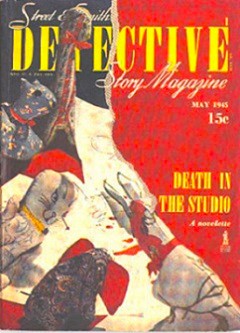
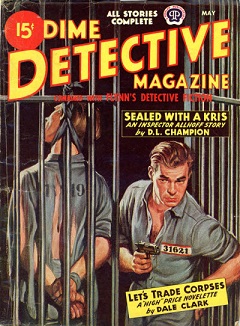
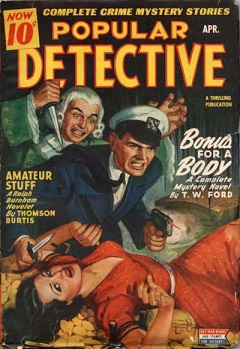
To view the entire list of weekly Old Time Radio episodes at Tangent Online, click here.